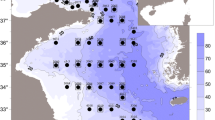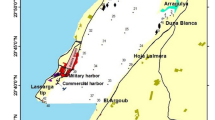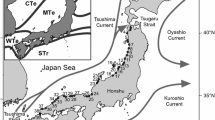Abstract
The structure of macro infaunal (>0.5 mm sieve size) assemblages was examined in samples of unconsolidated substrates collected during the summers of 1994–1997 at 208 stations throughout North Carolina estuaries. Numerical classification (cluster analysis) of stations resulted in 14 distinct site groups that reflected discernible habitatrelated patterns in species distributions. Multiple discriminant analysis, performed on synoptic abiotic variables (depth, salinity, dissolved oxygen, pH, percent silt-clay), showed that the separation of site groups was related primarily to salinity. Percent silt-clay had a secondary influence on the separation of sites within similar salinity zones. Species diversity among site groups generally decreased with decreasing salinity and increasing mud content of sediment. Nodal analysis showed a wide range in constancy and fidelity of species assemblages within site groups. Some assemblages dominated by euryhaline species had no particular affinity with any one site group. The strongest affinities, as evidenced by high values of both constancy and fidelity, were displayed by an assemblage of oligochaetes, insect larvae, gammaridean amphipods, and the clamCorbicula fluminea in tidal freshwater muds; and an assemblage of haustoriid amphipods, the bivalveDonax variabilis, the polychaeteParaonis fulgens, and unidentified echinoids at high-salinity sites in outer Pamlico Sound near ocean inlets. A series of stations with impaired benthic assemblages in polluted habitats emerged from the cluster analysis and was distinguishable from other site groups that reflected a greater influence of natural controlling factors (such as salinity and sediment type) on species distributions. These results suggest that the interaction of both anthropogenic and natural environmental controlling factors is important in defining the structure of these infaunal assemblages.
Similar content being viewed by others
Literature Cited
Alden, R. W., D. M. Dauer, J. A. Ranasinghe, L. C. Scott, andR. J. Llanso. 2002. Statistical verification of the Chesapeake Bay benthic index of biotic integrity.Environmetrics 13:473–498.
Boesch, D. F. 1977. Application of numerical classification in ecological investigations of water pollution. U.S. Environmental Protection Agency, ROAP/TASK No. 21, BEI. Corvallis Environmental Research Laboratory, Newport, Oregon.
Bray, J. R. andJ. T. Curtis. 1957. An ordination of the upland forest communities of southern Wisconsin.Ecological Monographs 27:320–349.
Brett, C. E. 1963. Relationships between marine invertebrate infauna distribution and sediment type distribution in Bogue Sound, North Carolina. Ph.D. Dissertation, University of North Carolina, Chapel Hill, North Carolina.
Cammen, L. M. 1979. The macro-infauna of a North Carolina salt marsh.The American Midland Naturalist 102:244–253.
Cerame-Vivas, M. J. andI. E. Gray 1966. The distributional pattern of benthic invertebrates off the continental shelf of North Carolina.Ecology 47:261–270.
Chester, A. J., R. L. Ferguson, andG. W. Thayer. 1983. Environmental gradients and benthic macroinvertebrate distributions in a shallow North Carolina estuary.Bulletin of Marine Science 33:282–295.
Clark, K. R. andR. M. Warwick. 1994. Change in marine communities: An approach to statistical analysis and interpretation. Plymouth Marine Laboratory, Plymouth, U.K.
Day, J. H., J. G. Field, andM. P. Montgomery. 1971. The use of numerical methods to determine the distribution of benthic fauna across the continental shelf of North Carolina.Journal of Animal Ecology 40:93–125.
Diaz, R. J. andR. Rosenberg. 1995. Marine benthic hypoxia: A review of its ecological effects and the behavioural responses of benthic macrofauna.Oceanography and Marine Biology: An Annual Review 33:245–303.
Engle, V. D., J. K. Summers, andG. R. Gaston. 1994. A benthic index of environmental condition of Gulf of Mexico estuaries.Estuaries 17:372–384.
Green, R. H. andG. L. Vascotto. 1978. A method for the analysis of environmental factors controlling patterns of species composition in aquatic communities.Water Research 12:583–590.
Hayek, L. C. andM. A. Buzas. 1997. Surveying Natural Populations. Columbia University Press, New York.
Holland, A. F. (ed.). 1990. Near coastal program plan for 1990: Estuaries. Environmental Protection Agency 600/4-90/033. Office of Research and Development, Narragansett, Rhode Island.
Hyland, J. L., L. Balthis, C. T. Hackney, G. McRae, A. H. Ringwood, T. R. Snoots, R. F. Van Dolah, andT. L. Wade. 1998a. Environmental quality of estuaries of the Carolinian Province: 1995. National Oceanic and Atmospheric Administration Technical Memorandum NOS ORCA 123. National Ocean Service, Silver Spring, Maryland.
Hyland, J. L., L. Balthis, C. T. Hackney, andM. Posey. 2000. Sediment quality of North Carolina estuaries: An integrative assessment of sediment contamination, toxicity, and condition of benthic fauna.Journal of Aquatic Ecosystem Stress and Recovery 8:107–124.
Hyland, J., E. Baptiste, J. Campbell, J. Kennedy, R. Kropp, andS. Williams. 1991. Macroinfaunal communities of the Santa Maria Basin on the California outer continental shelf and slope.Marine Ecology Progress Series 78:147–161.
Hyland, J. L., E. J. Hoffman, andD. K. Phelps. 1985. Differential responses of two nearshore infaunal assemblages to experimental petroleum additions.Journal of Marine Research 43: 365–394.
Hyland, J. L., T. R. Snoots, andW. L. Balthis. 1998b. Sediment quality of estuaries in the southeastern U.S.Environmental Monitoring and Assessment 51:331–343.
Hyland, J. L., R. F. Van Dolah, andT. R. Snoots. 1999. Predicting stress in benthic communities of southeastern U.S. estuaries in relation to chemical contamination of sediments.Environmental Toxicology and Chemistry 18:2557–2564.
Krebs, C. J. 1998. Ecological Methodology, 2nd edition. Pearson Benjamin Cummings, Menlo Park, California.
Lenihan, H. S. andC. H. Peterson. 1998. How habitat degradation through fishery disturbance enhances impacts of hypoxia on oyster reefs.Ecological Applications 8:128–140.
Llanso, R. J., L. C. Scott, D. M. Dauer, J. L. Hyland, andD. E. Russell. 2002a. An estuarine benthic index of biotic integrity for the Mid-Atlantic region of the United States. I. Classification of assemblages and habitat definition.Estuaries 25: 1219–1230.
Llanso, R. J., L. C. Scott, J. L. Hyland, D. M. Dauer, D. E. Russell, andF. W. Kutz. 2002b. An estuarine benthic index of biotic integrity for the Mid-Atlantic region of the United States. II. Index development.Estuaries 25:1231–1242.
Long, E. R., L. J. Field, andD. D. MacDonald. 1998. Predicting toxicity in marine sediments with numerical sediment quality guidelines.Environmental Toxicology and Chemistry 17:714–727.
Long, E. R., D. D. MacDonald, S. L. Smith, andF. D. Calder. 1995. Incidence of adverse biological effects within ranges of chemical concentrations in marine and estuarine sediments.Environmental Management 19:81–97.
Mallin, M. A., J. M. Burkholder, L. B. Cahoon, andM. H. Posey. 2000. North and South Carolina coasts.Marine Pollution Bulletin 41:56–75.
Pearson, T. H. andR. Rosenberg. 1978. Macrobenthic succession in relation to organic enrichment and pollution of the marine environment.Oceanography and Marine Biology Annual Review 16:229–31.
Posey, M. H. andW. G. Ambrose, Jr. 1994. Effects of proximity to an offshore hard-bottom reef on infaunal abundances.Marine Biology 118:745–753.
SAS Institute, Inc. 2000. SAS Online Doc, Version 8. SAS, Cary, North Carolina.
Shannon, C. E. 1948. A mathematical theory of communication.Bell System Technical Journal 27:379–423, 623–656.
Sneath, P. H. A. andR. R. Sokal. 1973. Numerical Taxonomy: The Principles and Practice of Numerical Classification. W.H. Freeman, San Francisco, California.
Tenore, K. R. 1972. Macrobenthos of the Pamlico River estuary, North Carolina.Ecological Monographs 42:51–69.
U.S. Environmental Protection Agency (EPA). 2000. Ambient aquatic life water criteria for dissolved oxygen (saltwater): Cape Cod to Cape Hatteras. EPA 822-R-00-012. Environmental Protection Agency, Office of Water, Washington, D.C.
U.S. Environmental Protection Agency (EPA). 2002. Environmental Monitoring and Assessment Program, Research Strategy. 620/R-02/002. Environmental, Washington, D.C.
Van Dolah, R. F., J. L. Hyland, A. F. Holland, J. S. Rosen, andT. R. Snoots. 1999. A benthic index of biological integrity for assessing habitat quality in estuaries of the southeastern USA.Marine Environmental Research 48:269–283.
Weisberg, S. B., J. A. Ranasinghe, D. M. Dauer, L. C. Schaffner, R. J. Diaz, andJ. B. Frithsen. 1997. An estuarine benthic index of biotic integrity (B-IBI) for Chesapeake Bay.Estuaries 20:149–158.
Weston, D. P. 1988. Macrobenthos-sediment relationships on the continental shelf off Cape Hatteras, North Carolina.Continental Shelf Research 8:267–286.
Williams, W. T. andJ. M. Lambert. 1961. Nodal analysis of associated populations.Nature 191:202.
Source of Unpublished Materials
Gallagher, E. Unpublished data. University of Massachusetts at Boston. 100 Morrissey Boulevard, Boston, Massachusetts. <http://www.es.umb.edu/edgwebp.htm>
Author information
Authors and Affiliations
Corresponding author
Additional information
An erratum to this article is available at http://dx.doi.org/10.1007/BF02803542.
Rights and permissions
About this article
Cite this article
Hyland, J.L., Balthis, W.L., Posey, M. et al. The soft-bottom macrobenthos of North Carolina estuaries. Estuaries 27, 501–514 (2004). https://doi.org/10.1007/BF02803541
Received:
Revised:
Accepted:
Issue Date:
DOI: https://doi.org/10.1007/BF02803541




